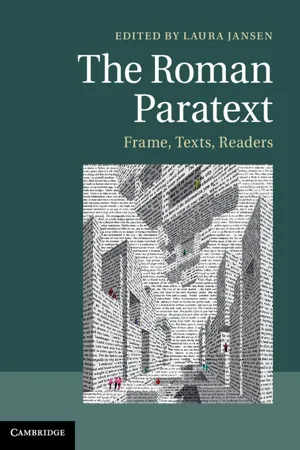About this book
What is a paratext, and where can we find it in a Roman text? What kind of space does a paratext occupy, and how does this space relate to the text and its contexts? How do we interpret Roman texts 'paratextually'? And what does this approach suggest about a work's original modes of plotting meaning, or the assumptions that underpin our own interpretation?These questions are central to the conceptual and practical concerns of the volume, which offers a synoptic study of Roman paratextuality and its exegesis within the broad sphere of Roman studies. Its contributions, which span literary, epigraphic and visual culture, focus on a wide variety of paratextual features - e.g. titles and inter-titles, prefaces, indices, inscriptions, closing statements, decorative and formalistic details - and other paratextual phenomena, such as the frames that can be plotted at various intersections of a text's formal organization.
Frequently asked questions
- Essential is ideal for learners and professionals who enjoy exploring a wide range of subjects. Access the Essential Library with 800,000+ trusted titles and best-sellers across business, personal growth, and the humanities. Includes unlimited reading time and Standard Read Aloud voice.
- Complete: Perfect for advanced learners and researchers needing full, unrestricted access. Unlock 1.4M+ books across hundreds of subjects, including academic and specialized titles. The Complete Plan also includes advanced features like Premium Read Aloud and Research Assistant.
Please note we cannot support devices running on iOS 13 and Android 7 or earlier. Learn more about using the app.
Information
Table of contents
- Cover
- Half-title
- Title page
- Copyright
- Contents
- Figures
- Contributors
- Acknowledgements
- Abbreviations
- Introduction: approaches to Roman paratextuality
- 1 Crossing the threshold: Genette, Catullus and the psychodynamics of paratextuality
- 2 Starting with the index in Pliny
- 3 The topography of the law book: common structures and modes of reading
- 4 Cicero’s capita
- 5 Tarda solacia: liminal temporalities of Statius’ prose prefaces
- 6 Intertitles as deliberate misinformation in Ammianus Marcellinus
- 7 Paratextual perspectives upon the SC de Pisone patre
- 8 Paratext and intertext in the Propertian poetry book
- 9 Pictorial paratexts: floating figures in Roman wall painting
- 10 The paratext of Amores 1: gaming the system
- 11 “Sealing” the book: the sphragis as paratext
- 12 Paraintertextuality: Spenser’s classical paratexts in The Shepheardes Calender
- 13 Modern covers and paratextual strategy in Ovidian elegy
- Bibliography
- Index of ancient literary sources
- General Index
